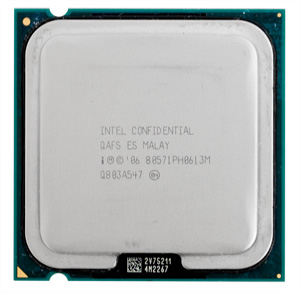Intel Core 2 Duo E7200, Eco-Friendly Performance
Specifications
Specifications
|
 Core 2 Duo E7200 - Top |
 Core 2 Duo E7200 - Bottom |
The Core 2 Duo E7200 is the slowest speed 45nm dual-core processor released to date at 2.53 GHz stock speed, the next closest offering being the Intel Core 2 E8200 model, which runs at a slightly higher clocked 2.66GHz with a full 6MB of cache. The E7200 processor runs at 5% slower clock speed and has half the cache at 3 MB, but also costs 30% less overall, and is currently selling for around $130, which would be considered high-end Celeron territory previously.
The Wolfdale architecture is based on Intel’s latest 45nm manufacturing process, which means the chip runs cool and doesn’t consume a lot of power, even under heavy loads. Intel rates the Core 2 Duo E7200 with a TDP of 65W, although we feel that even this is somewhat conservative, as the chip ran close to room temperature with very low noise cooling.
Each of the two processor cores have an individual 64k of L1 cache and they share a pool of 3 MB L2 cache. 3 MB is the smallest amount of cache offered in an Intel 45nm product to date, and this is essentially why many enthusiasts will stay away from this processor. At the same clock speed, we can expect a Wolfdale with a full 6MB of cache to perform 5-10% better under intensive applications (such as gaming). However, 3 MB of cache is still plenty big for many work loads, and as you’ll see in our following benchmarks, the chip still performs within pretty similar levels of the other Wolfdale chips (with larger caches) we’ve seen to date in most scenarios. The positive side of having less cache means that the chip is physically less complex, and in addition to the power and heat benefits that come along with that, it also means that the chips are extremely good overclockers, as we’ll look into later.
In addition to having a smaller amount of cache, the E7200 also runs down a notch on its frontside bus speed from the standard 1333 MHz on other current Core 2 Duo chips to a modest 1066 MHz front side bus speed. Don't be too concerned about this, as Core 2 Duo dual-core chips rarely have the opportunity to saturate the front side bus, and you can easily shoot it back up to 1333 MHz if you so choose (and frankly, we would recommend so). It’s still a very modern processor architecture, with support for 64-bit processing, SSE4, top-notch power management and Execute Disable support. However, we should note that the E7200 does not have support for hardware virtualization acceleration and does not support Intel’s TXT (Trusted Execution Technology), which ties in with their enterprise level security efforts. As this chip is targeted for consumer applications, this isn’t all that surprising. Although it’s disappointing to see, as these chips will undoubtedly make their way into low-cost / low-power / low-heat dual-core servers as well.
In order to run the new Core 2 Duo E7200, you will need to ensure that your motherboard and BIOS revision support Intel’s 45nm processors, as a BIOS update is needed for most systems that are older than six months. Most platforms in the last year will have BIOS support for this chip but we'd advise double-checking with the manufacturer. The latest round of motherboards based on a new chipset architecture like Intel's P35, X38,and X48 or NVIDIA's nForce 7x0i series should support this chip out of the box.






